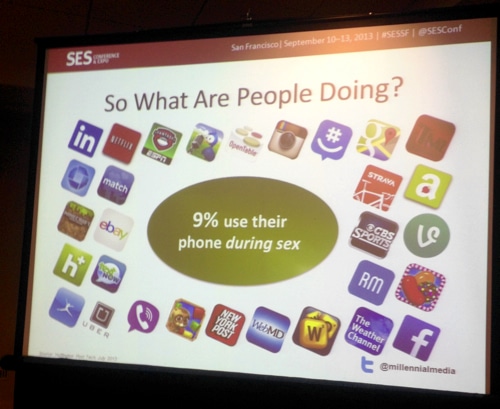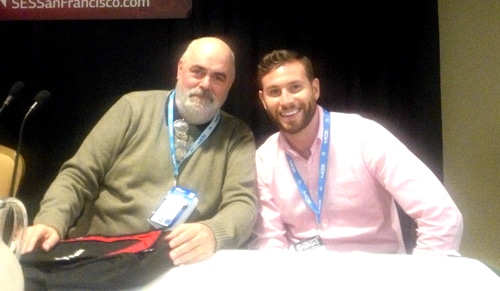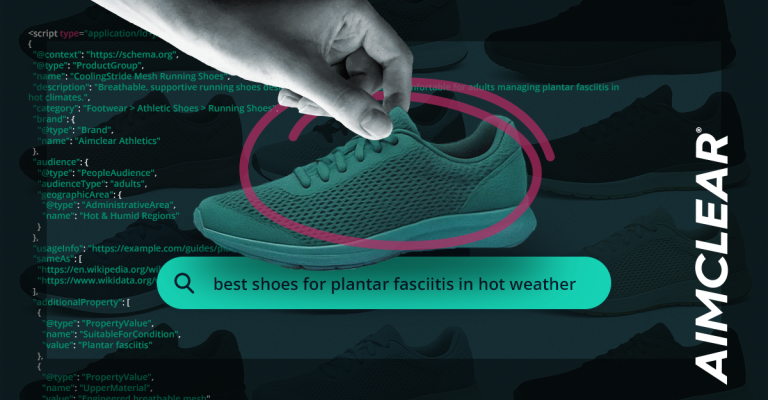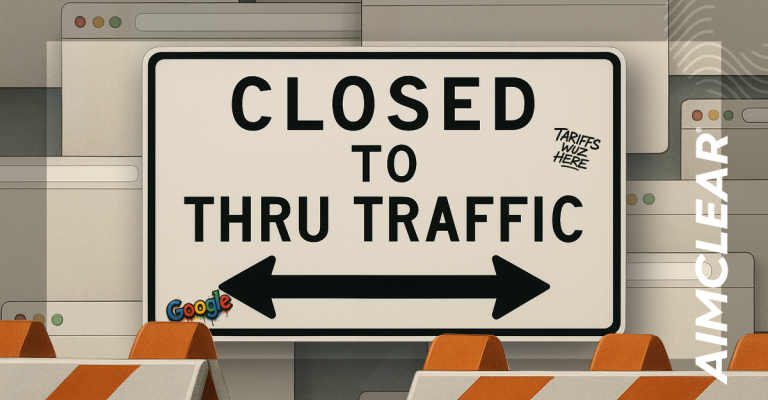Welcome to AIMCLEAR‘s coverage of SES San Francisco! As we continue with coverage of Day 1 here in San Fran, we gained quite the scoop as this session drew the crowd together for Secrets of Mobile Video: YouTube & Instagram & Vine, Oh My! Saddle up, and prepare yourself for some beefy mobile video takeaways. Giddy up, partner, and enjoy the SES ride!
Moderator, Melanie White, Special Projects Editor, ClickZ, kicked off the session by introducing panelists, Tony Gemma, Director of Sales Strategy, Millenial Media and Greg Jarboe, President & Co-founder, SEO-PR
Tony Gemma took to the floor to get things started. His first dose of wisdom: The consumer/brand relationship is just that…a relationship. According to Tony, we’re all dating. Sometimes consumers pick up the phone, other times they hit ignore. “Briding perfect marriage that brings brand and mobile together” was the sermon here.
Mobile is Enormous
We all know mobile is huge. In 2012, the number of mobile devices overtook the number of humans (~7 billion) in the world. Over time, we see mobile has eclipsed the PC world exponentially, and it’s not slowing down anytime soon. Digital is ingrained in everything we do, so it is essential we have devices that cater to our needs. So, what are people doing with mobile? Everything. From dating to reserving tables, there is no longer a separation – mobile has become part of the consumer”and in the center of all this mobile mania, mobile video is surging.
According to Tony, traditional consumption habits of video are switching to mobile. Movies have become the second most consumed content streamed by US mobile consumers: that’s a long term viewing session.
Top 3 Reasons Why Consumers Are Watching:
1.) Something I planned to watch
2.) Boredom or filling time
3.) A topic I like
Note: “Something I planned to watch”- This data tells us that mobile is becoming the first screen. THIS is important!
Consumers want what they want, when they want it. Mobile gives it to them.
It’s Fragmented
Tony went on to explain that there are two consumer habits when engaging with devices:
- Looking up: Not only is the phone with you, it’s getting things done. Habitual activities (skimming news headlines, checking scores, measuring fitness, downloading music, texting, etc.) can now be done on our phone, all while actually using the phone for it’s primary purpose: chatting.
- Looking down: Planned entertainment. You could be on the bus on the way to work for 30 minutes everyday playing Candy Crush, watching music videos, social stalking, or shopping online. This isn’t just a passerby vehicle – it’s an engagement vehicle.
Catching Consumers in the Right Mindset is Key
Marriage starts to take form by:
1.) Catching them in the right context. As a marketer, make sure you’re entering their world when they’re ready to receive your ad. (Things to consider: place and time, learned behavior, device, topics)
2.) Catching them in right experience. You know they’re in the right mindset, now you need to deliver. Build the proper message by providing consumer value and rooting in technology.
Tony brought up an example of looking at an interest graph (topics and influencers). As a marketer, we can make a deduction that we are tracking a male sports fan. To dig deeper, we can insert cookies and find out that after he goes to ESPN, he goes to a site about parenting. Along comes social, and BOOM – now you can find his passions and whom he’s willing to connect with. This is how you should be building your audience segments.
Takeaway: Mobile tells us more than any other medium.
Location, Location, Location (Graph, That Is)
The location graph has become the mother of all mobile, according to Tony. That sweet victory of serving an ad the moment they’re in front of a store. But even more importantly, are the learned behaviors we can gather from this.
For example: A device goes into a middle school five days a week. Then you see them go to a park three days a week. One could assume they have a middle-schooler in their lives. Power of mobile: it’s not just location. Pair this information with all the other graphs (has children, visits Oprah everyday, etc.) and from there you may be able to glean that you have an active mom who is dropping kids off everyday.
Understand waves and motions of life: You’re learning about this person so actively with real time exposure, enrolling and un-enrolling them into your advertising strategy, so do your homework before serving any old ad.
Provide The Right Experience
They’ve given you the information; they don’t want you to just call them. Get to know them. Give them what they want to get that date. Show-stopping entertainment. Give them a deal. Give them your reason for being in their lives.
Tony shared superb examples of brands marketing from the looking up and looking down perspective:
“Looking Up” : Adidas
- Context: 3 hours prior to Adizero Launch event, Adidas served around 100,000 impressions (he couldn’t share the juicy data details) of ads in the 3 mile radius around NY’s Penn Station, when consumers were close enough to “pop-in.”
- Experience: Adidas served mobile banners “teasing” entry to event: “Check Out After Dark”. Once clicked, this brought consumers to a short, promotional video with all the details for location and entry.
“Looking Down” : Wells Fargo
- Context: While at home, during primetime TV hours, Wells Fargo deployed ads to consumers in higher household incomes, who were “winding down” for the evening.
- Experience: Ads were served to tablets only, with a touch screen interactive video.
That’s how you get married. But remember: with every marriage comes a lot of work, and sometimes that means therapy. You never want to blindly throw money into mobile. Measure with purpose. A click doesn’t always correlate to scales.
Lastly, Measure With Purpose
- Audience Behavioral Insights
- Look at back-to-front: Parents were looking at campaign. Target parents for next campaign.
- Impact on Online Lift
- Work with a 3rd party to analyze where consumers go online after they’ve seen a mobile ad.
- Impact of In-Store Foot Traffic
- Follow consumers in stores (weeks and months) after they receive an ad. See how much lift they had for in store traffic and competitive insights.
- Impact on In-Store Purchases
- From mobile ads, look at how households are spending after ads, (Warning: this can get complicated, but is a good indication of good ad sense to learn how you’re pushing people to start spending with traffic.)
- Impact on Brand Metrics
- People forget they should use similar metrics, measure attitudinal life, purchase intent, etc.
- Impact on Mobile Lift
- Important for brands that have mobile experience: How people use their apps after they’re served an ad.
With that, Tony turned the mic over to Greg.
Greg began his session by asking how many attendees were under 35. Then how many were over. The results were about 50/50. He continued, making the statement that 35 is the magic line according to market research, dividing those into two groups, digital natives (those who didn’t know there was once a time phones were attached to cords) and digital immigrants (those who had to learn the internet stuff the hard way). It is crucial to understand the difference between these demographics as a marketer because:
“…No matter what marketing organization you’re in, there are people on both sides. It is your job to serve as a translator to them.”
“Horses For Courses”
Many people are looking for a silver bullet.
(Example: Marketer “I’m going to do mobile video” Greg: “Then what?” Marketer: *silence*)
- There is no silver bullet; one size fits all; “that thing”. Whatever is successful today will change in a couple of months.
- What will not change is to understand that you know your job will change, and know when to use it.
Five W’s and One H
If you’ve ever taken a writing course, you know the five W’s and one H (Who, What, Where, When, Why, How). Greg urged that as marketers, we could steal this. Why? Generally, a journalist deals with something they haven’t seen before- to explain to people who weren’t there. For marketing it works too, arguably even better than 4P’s of Marketing, as the 5th major ‘P’ is left out: who the heck is your Prospect?! (Greg went on to say if you don’t know that, God bless you.) No one is successful these days trying to sell to everyone.
- WHO are the people you need to put at the top of your list?
- WHO are we making this thing for?
- WHAT type of content are we going to build for them?
- It is here we can tackle methods (Vine, Instagram, YouTube)
- WHERE will it be consumed? Are you only interested in a prospect when they’re on their smart phone?
- Lastly, measurement is key: Measure business outcomes, not marketing outputs
Ask yourself this before someone else asks you: HOW many views do I need before I sell a car? HOW many of these do I need before a sale? Then you can determine ROI.
So Who Are These Weirdos?
According to data found in June 2013, they’re us. 56% of adults own smartphones and 34% own tablets. It’s happening NOW and it’s important to know which device you want to work with. It’s a big audience that is growing fast and skewed.
- Skewing younger, this is where the divide comes in.
- When it comes to tablets: it’s the over 35 driving the divide.
- With different demographics, you probably want to (or should) sell to both segments. Understand they’re different people, with different devices, using them for different purposes.
A year ago, Google coined “Gen V”. Now, YouTube has coined ” Gen C”. The difference?
1.) They’re “Gen V” with a new name.
2.) It’s not a different demographic – its psychographic. They’re using mobile devices (no matter age group) during the day at the same rate they’re using their desktop. If you can crack the code on this mobile thing, you can crack the code on the desktop thing, too. As a marketer, you want to market to them because they buy around $500B of spend a year
“…So What The Hell Are They Watching?”
YouTube divides popular channels on mobile AND tablet, only guess what? There’s a pattern. It’s entertainment and comedy: the same channels they’re watching on desktop. Here’s the mystery: They were watching it on desktop, now are watching it on a smaller screen (Except when you get to tablets – they are the anomaly- over 35. There is specialization here.)
Greg used the example of the YouTube channel MichellePhan (Beauty and Fashion tutorials), one of the most popular channels on tablets, for those who need a big screen. So how do you cash in? Product placement! As Michelle was doing her makeup tutorial, someone (smart) paid her to wear a blond wig. I think you get where this is headed but the sellers of those wigs? Cha-ching.
New Video Trends
Greg shared Unruly’s findings of emerging social media trends mid-way through 2013:
- Meme- Jacking: Around 40,000 Harlem shake videos have been uploaded from the Miami Heat, to Seaworld, to (Greg’s personal favorite) The Norwegian army.
- How do you tap in to big and little screen? Find out what is happening and like Tonto, “Jump on it”!
- The Trend to Offend: Creating controversial content (think K-Mart’s “Ship My Pants” took a risk.
- Take a risk to be edgy (Note: Greg recommends testing before rolling out.)
- Prankverts: “Punk ” ads have enjoyed a lot of success (Pepsi’s “Test Drive”, Niveas, “Stress Test”)
- Stop-Motion Revival: Vine’s Intuitive controls and easily digitized length makes it easier than ever to make your own top-motion masterpiece.
- Teaser Your Product: Think Instagram or ‘Tweaser’ for those using Vine. Videos in the 6-15 second region.
- How-To: There are some things so simple you can teach someone to do it in 6-15 seconds. (A lot of your products that you can teach consumers to use to solve their problems. Hint, hint.)
Get Comfortable With These Products:
- Vine
- Start thinking in the 6-second realm.
- Now supports Android
- Front-facing shooting capability.
- Free.
- Instantly post videos from Vine to share on Twitter and Facebook.
- Instagram
- You get 15 seconds, but it doesn’t loop.
- Customize videos with more than a dozen filters.
- Ability to choose cover image from favorite scene.
- Instantly share videos to Facebook, Twitter, Tumblr, Flickr, and Foursquare.
- YouTube capture (Big Secret!)
- You can upload video to YouTube, Facebook, Twitter, and Google+ simultaneously.
- No time limit!
- Time-editing software.
- Ability to add free background music.
Why do you need “Horses for courses” instead of the best mobile video?
The mobile video horserace between YouTube, Instagram, and Vine has only just begun. Play around with them; Pay no attention to those trying to pick one channel. For every survey declaring a “winner”, there’s another survey contradicting.
Lastly, Greg offered some key psychological responses that affect shareability that Unruly has identified: Optimize your content for sharing and Start with a bang. Remember to do your homework: People are more likely to share warm, fuzzy feelings than scary, negative thoughts.
Final thoughts on measuring success: Google Glass. Until pay-per-gaze advertising arrives, measuring success will be a challenge. Keep on experimenting.
So, there you have it. Don’t forget to check AIMCLEAR‘s #SESSF coverage all week long. If you’ve had any candles of concern or joy with mobile video recently, we’d love to hear them!











